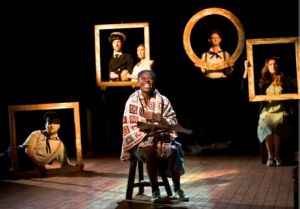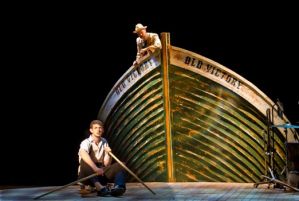Swallows and Amazons is a quintessentially English story: a heart-warming hymn to decent values, the codes of sailing and the youthful spirit of adventure. Set in 1929, at a time when the country faced financial meltdown, it is perhaps not surprising, in our equally uncertain times, that Arthur Ransome’s feelgood Lakeland classic should have been adapted for the stage. Tom Morris’s production of a very well-handled adaptation by Helen Edmundson with music and songs by Neil Hannon - better known as The Divine Comedy - fizzes with spirit and sparkles with invention.
The original book, about a group of kids who mess about with boats and allow their fantasies to run free and weave a captivating narrative of noble seafarers and dastardly pirates, derives its magic from the imagination-fuelled way in which children play. The universe of make-believe they create is at odds with the humdrum reality imposed by parents, the “Barbarians”, as they call them, no longer capable of dreaming and blind to the rich and magical world around them.
This production plays strongly to this essential aspect of Ransome’s world, exploiting with a marvellous sense of invention all the possibilities of a theatrical experience where the audience plays along with the cast in imagining the unfolding of the show: boats, water, reeds are all conjured with the minimum of physical props, in the manner made familiar by those trained by Jacques Lecoq – from Complicite to Robert Lepage.
The sound effects, too, are startling – from an invisible but very tangible campfire evoked by a miniature symphony of finger-snapping and handclaps, to the sound of water lapping against a boat-side produced in a large water bottle. And yet, there is at times something a little laboured in this purposeful evocation of the imagination – almost as if the company were trying too hard to sell us the power of “as if”. There is real brio here, but it occasionally feels just a little bit clunky, though I suspect that the children in the audience don’t mind at all. The story’s Englishness is strongly reflected in the contrast between the two main groups of protagonists: the awfully nice Swallows (the Walker family) led by Cap’n John, ably played as officer material by Stuart McLoughlin, and a crew including prim Susan (Rosalie Craig) who is always worried that “mother wouldn’t like it”, Roger, the youngest, played to good and comical effect by a relatively large actor, Stewart Right, and last but certainly not least, Titty Walker whose effervescence is rendered with great panache by Akiya Henry (pictured above), a charismatic actress and singer who very nearly steals the show.
The story’s Englishness is strongly reflected in the contrast between the two main groups of protagonists: the awfully nice Swallows (the Walker family) led by Cap’n John, ably played as officer material by Stuart McLoughlin, and a crew including prim Susan (Rosalie Craig) who is always worried that “mother wouldn’t like it”, Roger, the youngest, played to good and comical effect by a relatively large actor, Stewart Right, and last but certainly not least, Titty Walker whose effervescence is rendered with great panache by Akiya Henry (pictured above), a charismatic actress and singer who very nearly steals the show.
The Amazons are the rebels of the piece: while the Swallows are playing at being future members of the establishment, the Blackett sisters strut around like proto-punks, keen to shock with shows of violence and bad behaviour. Celia Adams as Nancy plays the part forcefully though her performance is a little one-dimensional until the vulnerability beneath her brash exterior becomes apparent in the latter part of the show.
This is very much an ensemble piece: the less central roles are taken by actors who also play musical instruments, produce a variety of sound effects and handle the minimal props which evoke the sailing boats, scenery, a variety of wild fowl (including a menacing cormorant) and other elements of the imaginative whole which goes through an endless series of eye-catching mutations. Hannon's songs work well as vehicles for the lead actors, not least to underscore the show of strength from the Blackett sisters – decked out in costumes that evoke the Girl Guides as much as tribespeople from the Amazon basin - but also expressing the richness and complexity of individual characters: John Walker has a poetic side reflected in a song about the darkness falling over the lake, and Titty’s solo spot reveals something deeper than the ebullience which mostly defines her.  In the finale, Robert Innes Hopkins’s skills as a designer finally become fully apparent: with Captain Flint’s large boat “Old Victory” dominating the stage (pictured left), there is a fitting and rambunctious climax, with much song and dance and some engaging audience participation – allowing the children and child-spirited members of the audience to hurl foam projectiles at the beleaguered Flint, and to perilously carry over their heads, body-surfing style, two beautiful models of the Swallow and Amazon, launched by the company as a kind of gift to the audience. The end of the story sees the imagination and the world of children vindicated, as the grown-ups recognise the reality of the fantasy world that has been played out across the lake and its islands. What is never clear, and it is right that it should remain so, is whether this transformation of the “Barbarians” into playmates is itself no more than yet another act in the children’s effortless games of make-believe.
In the finale, Robert Innes Hopkins’s skills as a designer finally become fully apparent: with Captain Flint’s large boat “Old Victory” dominating the stage (pictured left), there is a fitting and rambunctious climax, with much song and dance and some engaging audience participation – allowing the children and child-spirited members of the audience to hurl foam projectiles at the beleaguered Flint, and to perilously carry over their heads, body-surfing style, two beautiful models of the Swallow and Amazon, launched by the company as a kind of gift to the audience. The end of the story sees the imagination and the world of children vindicated, as the grown-ups recognise the reality of the fantasy world that has been played out across the lake and its islands. What is never clear, and it is right that it should remain so, is whether this transformation of the “Barbarians” into playmates is itself no more than yet another act in the children’s effortless games of make-believe.
- Swallows and Amazons at Bristol Old Vic until 15 January, 2011
- Find Arthur Ransome's Swallows and Amazons on Amazon















Add comment